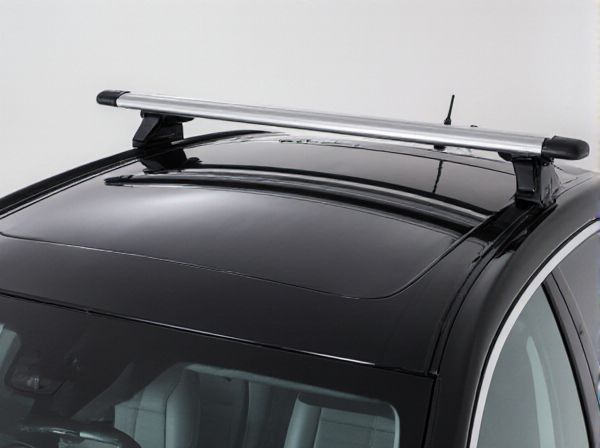
Photo illustration: Removable Roof vs Convertible Roof
A removable roof offers the flexibility to completely detach the panel for open-air driving, providing a more traditional coupe feel when reinstalled. A convertible roof, typically made of fabric or retractable hardtop materials, folds away automatically, allowing you to transition between closed and open modes effortlessly. Your choice depends on preferences for convenience, style, and the driving experience you desire.
Table of Comparison
| Feature | Removable Roof | Convertible Roof |
|---|---|---|
| Design | Detachable solid panel for open-air experience | Retractable fabric or hardtop integrated into car body |
| Installation | Manually removed and stored separately | Operates with automated or manual folding mechanisms |
| Weight | Heavier due to solid construction | Lighter with fabric, heavier with hardtop versions |
| Weather Protection | Good insulation, fully sealed when attached | Varies; fabric roofs less insulating than hardtops |
| Maintenance | Simple; remove and clean periodically | Requires mechanical upkeep of moving parts |
| Storage | Needs external space for roof panel storage | Stored internally within vehicle structure |
| Cost | Generally lower initial cost | Higher cost due to complex mechanisms |
| Security | Solid panel provides better theft deterrence | Fabric roofs less secure than solid roofs |
Introduction to Removable Roofs and Convertible Roofs
Removable roofs are solid panels that can be physically lifted or detached from the vehicle, providing the flexibility to switch between enclosed and open-air driving. Convertible roofs are typically fabric or soft-top designs that retract or fold automatically, offering seamless transformation from a closed cabin to an open roof. Both roof types enhance driving experience by balancing protection and openness, with removable roofs favoring rigidity and security while convertibles prioritize convenience and style.
Key Differences Between Removable and Convertible Roofs
Removable roofs are detachable panels, often made of hard materials like fiberglass or metal, which require manual removal and storage, providing a solid, weather-resistant option when in place. Convertible roofs consist of a foldable fabric or soft top system integrated into the vehicle's design, allowing for quick transition between open and closed modes through automated or manual mechanisms. Key differences include ease of operation, with convertible roofs offering swift conversion, and weather protection, where removable roofs typically provide better insulation and durability.
Advantages of Removable Roofs
Removable roofs offer enhanced structural rigidity and better weatherproofing compared to convertible roofs, providing a more secure and insulated driving experience. They allow for simpler maintenance and reduced mechanical complexity since they can be manually detached without relying on hydraulic or electric systems. This design also typically results in a lighter overall vehicle weight, improving fuel efficiency and handling performance.
Benefits of Convertible Roofs
Convertible roofs offer enhanced versatility by allowing drivers to switch between open-air and enclosed driving experiences, improving comfort and convenience. Advanced materials and mechanisms provide superior weather protection and noise insulation compared to removable roofs. Their integrated design reduces the risk of losing parts and simplifies storage, making convertible roofs a practical choice for modern vehicles.
Design and Engineering Comparison
Removable roofs feature rigid panels designed for easy detachment, providing structural rigidity and weather protection when in place, while convertible roofs use complex folding mechanisms allowing seamless transition between open and closed configurations. Removable roofs prioritize simplicity and durability with fewer moving parts, resulting in reduced mechanical failure risks, whereas convertible roofs demand advanced engineering for hydraulic or electric operation systems and reinforced frame structures to maintain chassis integrity. The choice impacts aerodynamics, weight distribution, and vehicle center of gravity, with removable roofs often contributing to a stiffer chassis and convertible roofs requiring additional reinforcements to compensate for the roof's flexibility.
Durability and Maintenance Factors
Removable roofs typically offer greater durability as they are designed to be securely fastened and are often constructed from rigid materials that withstand weathering better than convertible roofs. Convertible roofs, composed of fabric or soft materials, require more frequent maintenance, including waterproofing treatments and fabric replacements to prevent wear and tear. Regular inspection and care are essential for both roof types, but convertible roofs generally demand higher maintenance efforts due to their complex mechanical components and exposure to environmental elements.
Safety Features and Considerations
Removable roofs offer robust safety features such as reinforced frames and secure locking mechanisms that provide structural integrity and protection during accidents. Convertible roofs incorporate advanced safety technologies like rollover protection systems and impact-absorbing materials to enhance occupant safety when the roof is down. Both roof types require careful consideration of crash test ratings, weather sealing, and ease of emergency egress to ensure comprehensive safety performance.
Weather Protection and Comfort
Removable roofs offer robust weather protection by creating a solid barrier against rain, wind, and extreme temperatures, ensuring consistent cabin comfort. Convertible roofs, often made from fabric or soft materials, provide less insulation and are more susceptible to leaks and drafts, potentially reducing comfort in harsh weather conditions. Choosing a removable roof enhances environmental control inside the vehicle, while convertible roofs prioritize open-air experience with moderate weather resilience.
Cost Comparison: Removable vs Convertible Roofs
Removable roofs generally cost less upfront compared to convertible roofs due to simpler mechanisms and fewer moving parts, which reduce manufacturing and maintenance expenses. Convertible roofs involve complex hydraulic or electric systems that increase initial purchase prices and long-term repair costs. Over time, removable roofs often prove more budget-friendly for owners prioritizing affordability and straightforward roof removal.
Choosing the Right Roof Type for Your Needs
Choosing between a removable roof and a convertible roof depends on your lifestyle and driving preferences. Removable roofs offer the flexibility to completely detach the top for an open-air experience and enhanced structural rigidity when installed, making them ideal for those who prioritize performance and easy maintenance. Convertible roofs provide the convenience of retracting the soft or hardtop with minimal effort, perfect for drivers seeking quick transitions between closed and open configurations without the need to store panels separately.
 caratoz.com
caratoz.com